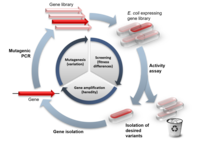
Photo from wikipedia
&NA; Protein structures strongly influence molecular evolution. In particular, the evolutionary rate of a protein site depends on the number of its native contacts. Stability‐constrained models of protein evolution consider… Click to show full abstract
&NA; Protein structures strongly influence molecular evolution. In particular, the evolutionary rate of a protein site depends on the number of its native contacts. Stability‐constrained models of protein evolution consider this influence of protein structure on evolution by predicting the effect of mutations on the stability of the native state, but they currently neglect how mutations affect the protein structure. These models predict that buried protein sites with more native contacts are more constrained by natural selection and less variable, as observed. Nevertheless, previous work did not consider the stability against compact misfolded conformations, although it is known that the negative design that destabilizes these misfolded conformations influences protein evolution significantly. Here, we show that stability‐constrained models that consider misfolding predict that site‐specific sequence entropy and substitution rate peak at amphiphilic sites with an intermediate number of contacts, as these sites are less constrained than exposed sites with few contacts whose hydrophobicity must be limited. This result holds both for a mean‐field model with independent sites and for a pairwise model that takes as a reference the wild‐type sequence, but it contrasts with the observations that indicate that the entropy and the substitution rate decrease monotonically with the number of contacts. Our work suggests that stability‐constrained models overestimate the tolerance of amphiphilic sites against mutations, either because of the limits of the free energy function or, more importantly in our opinion, because they do not consider how mutations perturb the native protein structure.
Journal Title: Molecular Biology and Evolution
Year Published: 2017
Link to full text (if available)
Share on Social Media: Sign Up to like & get
recommendations!